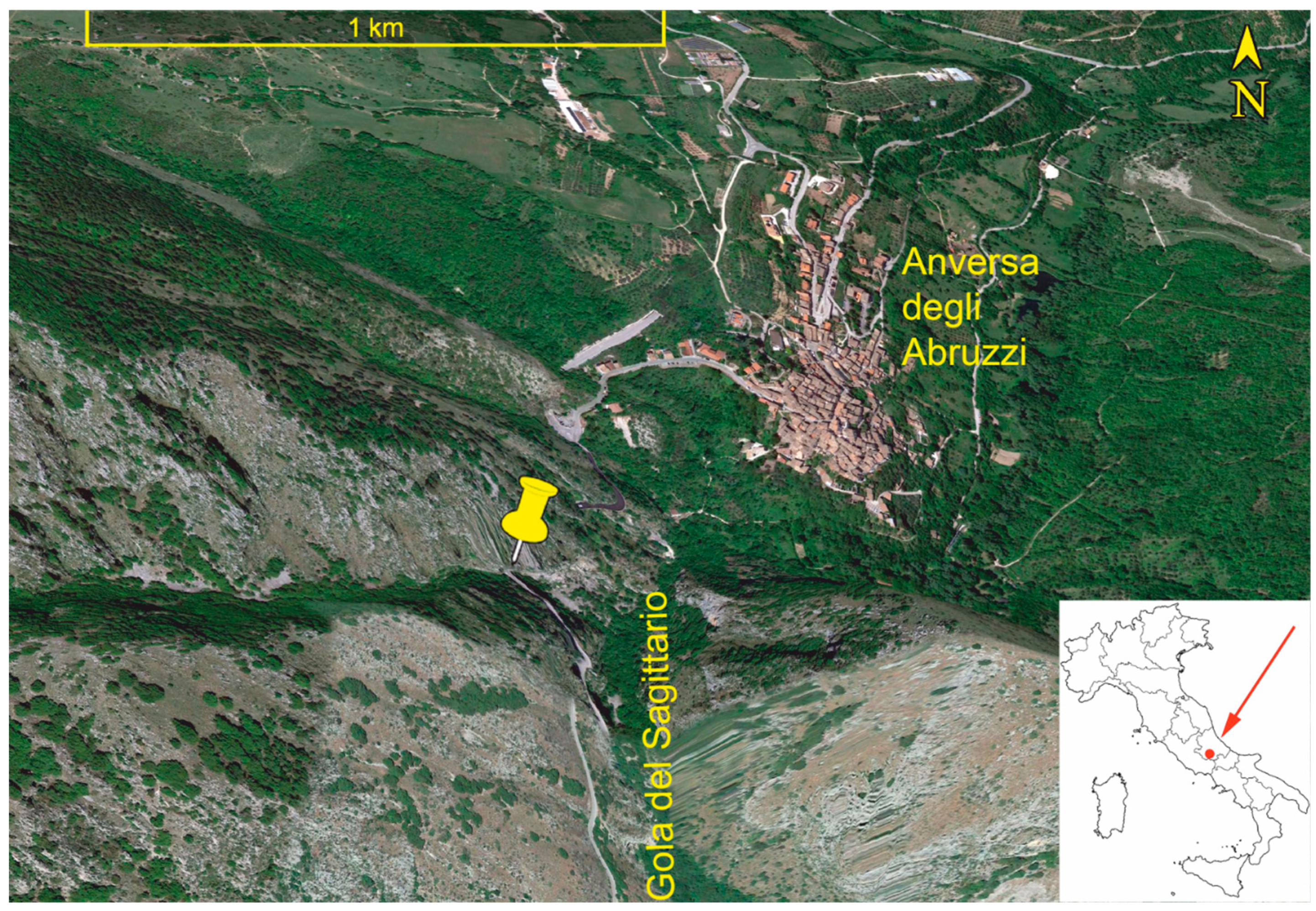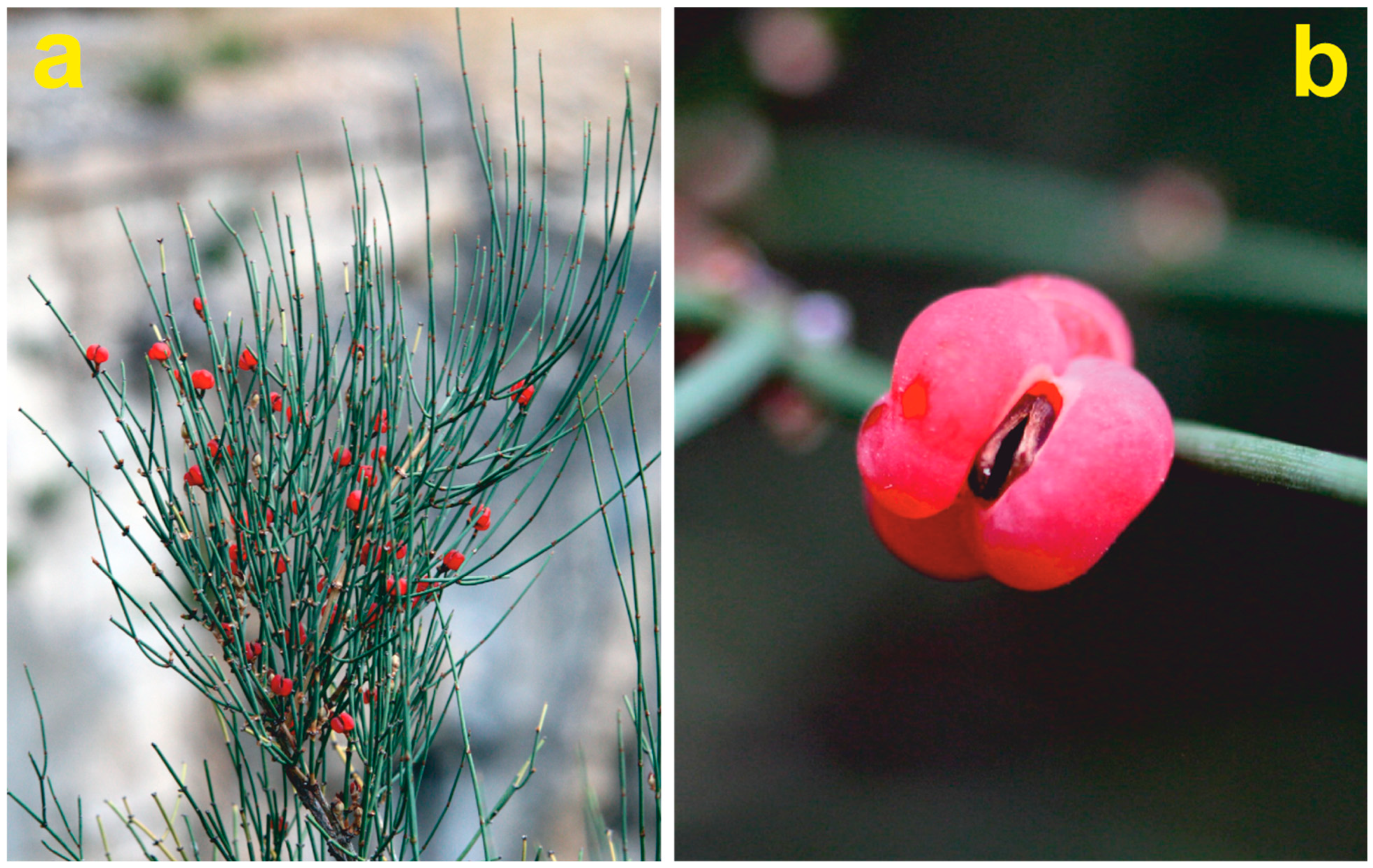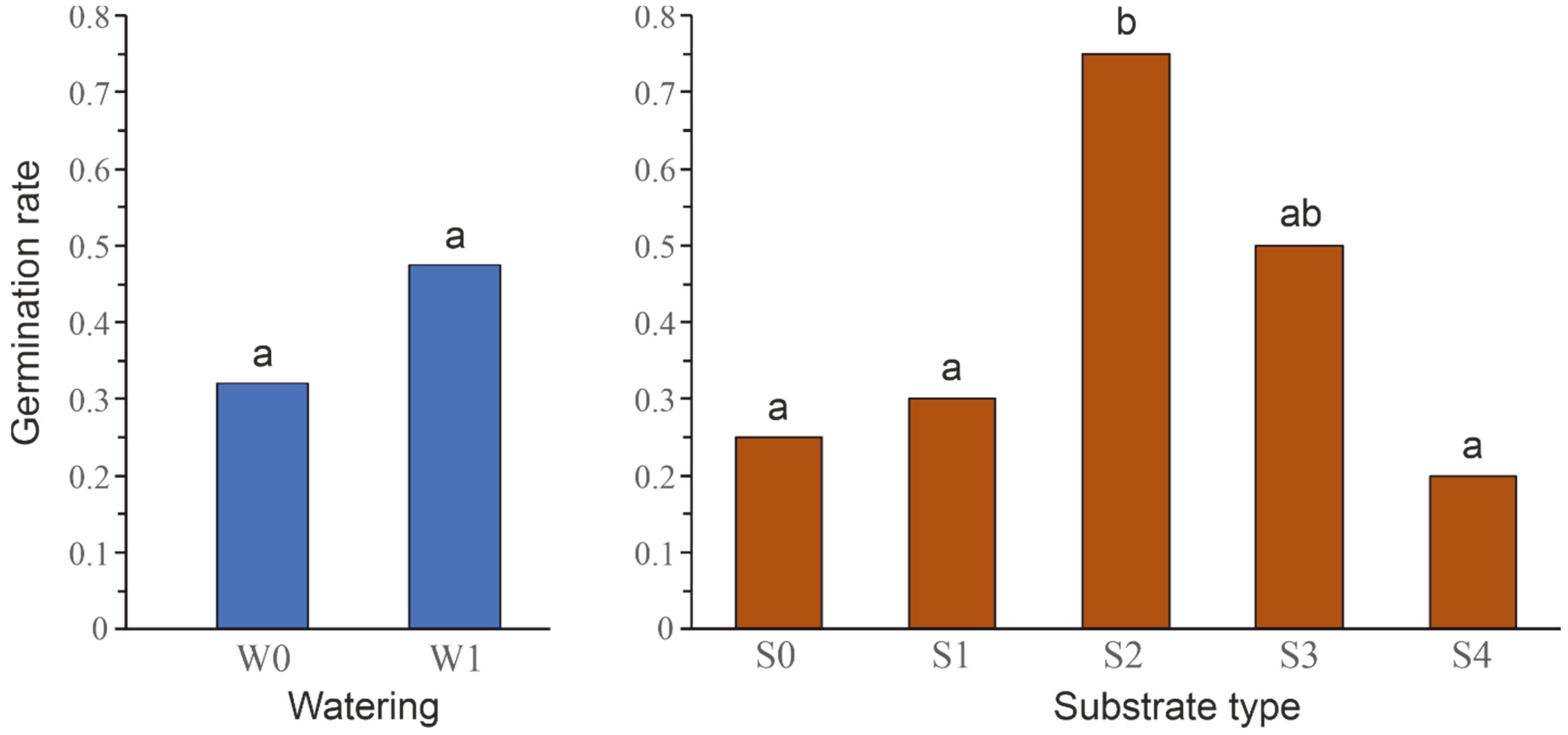Soil Quality Enhances Seed Germination Success in Ephedra major—A Pilot Experiment
Abstract
1. Introduction
2. Materials and Methods
2.1. Study Area
2.2. Cone Collection and Drying
2.3. Experimental Design
2.4. Data Analyses
3. Results
4. Discussions
5. Preliminary Conclusions and limitations
Author Contributions
Funding
Institutional Review Board Statement
Informed Consent Statement
Data Availability Statement
Acknowledgments
Conflicts of Interest
References
- The IUCN Red List of Threatened Species. Version 2022-1. Available online: https://www.iucnredlist.org/species/201716/9172369 (accessed on 12 October 2022).
- Conti, F.; Abbate, G.; Alessandrini, A.; Blasi, C. An Annotated Checklist of the Italian Vascular Flora; Palombi Editori: Roma, Italy, 2005; pp. 1–420. [Google Scholar]
- Orsomando, E. Areale italiano di Ephedra nebrodensis (Tin.). Mitt. Der Ostalpin-Dinarischen Pflanzensoziol. Arb. 1969, 9, 341–348. (In Italian) [Google Scholar]
- Pignatti, S. Flora d’Italia; Edagricole: Bologna, Italy, 1982; Volume 1, pp. 1–790. (In Italian) [Google Scholar]
- Freitag, H.; Maier Stolte, M. Ephedra L. In Flora Europaea, 2nd ed.; Tutin, T.G., Burges, N.A., Chater, A.O., Edmondson, J.R., Heywood, V.H., Moore, D.H., Valentine, D.H., Walters, S.M., Webb, D.A., Eds.; Cambridge University Press: Cambridge, UK, 1993; Volume 1, pp. 1–49. [Google Scholar]
- Dobignard, A.; Chatelain, C. Index Synonymique de la Flore d’Afrique du Nord; Éditions des Conservatoire et Jardin Botaniques: Genève, Switzerland, 2011; Volume 3, pp. 1–449. (In French) [Google Scholar]
- Bartolucci, F.; Peruzzi, L.; Galasso, G.; Albano, A.; Alessandrini, A.; Ardenghi, N.M.G.; Astuti, G.; Bacchetta, G.; Ballelli, S.; Banfi, E.; et al. An updated checklist of the vascular flora native to Italy. Plant Biosyst. 2018, 152, 179–303. [Google Scholar] [CrossRef]
- Brullo, S.; Del Guacchio, E. Proposal to reject the name Ephedra major (Ephedraceae). Taxon 2021, 70, 431–432. [Google Scholar] [CrossRef]
- Del Guacchio, E.; Cambria, S.; Brullo, S. Typification of the name Ephedra nebrodensis (Ephedraceae). Phytotaxa 2021, 496, 90–92. [Google Scholar] [CrossRef]
- Yang, Y. A numerical analysis of Ephedra L. based on reproductive features. Bangladesh J. Plant Taxon. 2013, 20, 51–60. [Google Scholar] [CrossRef]
- González-Juárez, D.E.; Escobedo-Moratilla, A.; Flores, J.; Hidalgo-Figueroa, S.; Martínez-Tagüeña, N.; Morales-Jiménez, J.; Muñiz-Ramírez, A.; Pastor-Palacios, G.; Pérez-Miranda, S.; Ramírez-Hernández, A.; et al. A Review of the Ephedra genus: Distribution, Ecology, Ethnobotany, Phytochemistry and Pharmacological Properties. Molecules 2020, 25, 3283. [Google Scholar] [CrossRef] [PubMed]
- FloraVeg.EU—Database of the European Flora and Vegetation. Available online: https://floraveg.eu (accessed on 12 October 2022).
- Dadkhah, A. Allelopathic effect of Ephedra major on growth and photosynthesis of Cirsium arvense weed. Int. J. Agric. Res. Rev. 2012, 2, 416–419. [Google Scholar]
- Young, J.A.; Evans, R.A.; Kay, B.L. Ephedra seed germination. Agron. J. 1977, 69, 209–211. [Google Scholar] [CrossRef]
- Al-Taisan, A.W.; Al-Qarawi, A.A.; Alsubiee, M.S. Effect of water stress by Polyethylene Glycol 8000 and Sodium Chloride on germination of Ephedra alata Decne seeds. Saudi J. Biol. Sci. 2010, 17, 253–257. [Google Scholar] [CrossRef]
- Rodríguez Araujo, M.E.; Milano, C.; Pérez, D.R. Germination of Ephedra ochreata Miers: Contribution for productive restoration of arid environments in Argentina. Agrociencia 2019, 53, 617–629. [Google Scholar]
- Mussarat Nasreen, A.; Khan, A.A.; Haider Zaidi, S. Seed germination of Ephedra nebrodensis. Pak. J. For. 1979, 29, 118–119. [Google Scholar]
- Mofid Bojnoordi, M.; Aghdasi, M.; Mianabadi, M.; Nadaf, M. An investigation on optimization of germination and ephedrine level in Ephedra major. J. Plant Process Funct. 2015, 3, 29–38. (In Persian) [Google Scholar]
- Cianfaglione, K.; Bartolucci, F.; Ciaschetti, G.; Conti, F.; Pirone, G. Characterization of Thymus vulgaris subsp. vulgaris community by using a multidisciplinary approach: A case study from Central Italy. Sustainability 2022, 14, 3981. [Google Scholar] [CrossRef]
- World Reference Base for Soil Resources 2014. Update 2015; World Soil Resources Reports 106; FAO: Rome, Italy. 2015, pp. 1–192. Available online: http://www.fao.org/3/i3794en/I3794en.pdf (accessed on 12 October 2022).
- Ferretti, M. (Ed.) Regione Marche. Annali Idrologici; Parte prima; Centro Funzionale Multirischi per la Meteorologia, l’Idrologia e la Sismologia: Ancona, Italy, 2008; pp. 1–80. [Google Scholar]
- Ferretti, M. (Ed.) Regione Marche. Annali Idrologici; Parte prima; Centro Funzionale Multirischi per la Meteorologia, l’Idrologia e la Sismologia: Ancona, Italy, 2009; pp. 1–79. [Google Scholar]
- SAS Institute Inc. JMP ®16 Fitting Linear Models; SAS Institute Inc.: Cary, NC, USA, 2021; pp. 1–583. [Google Scholar]
- Pettit, R.E. Organic matter, humus, humate, humic acid, fulvic acid and humin: Their importance in soil fertility and plant health. CTI Res. 2008, 10, 1–17. [Google Scholar]
- Andreetta, A.; Macci, C.; Ceccherini, M.; Cecchini, G.; Masciandaro, G.; Pietramellara, G.; Carnicelli, S. Microbial dynamics in Mediterranean moder humus. Biol. Fertil. Soils 2012, 48, 259–270. [Google Scholar] [CrossRef]
- Kigel, J. Seed germination in arid and semiarid regions. In Seed Development and Germination; Kigel, J., Galili, G., Eds.; Routledge Pub.: New York, NY, USA, 1995; pp. 645–701. [Google Scholar]
- Baranec, T.; Řehořek, V.; Svodobová, Z.; Ulrych, L. Generative reproduction of Ephedra (Ephedra distachya L) in Slovakia. Biologia 1994, 49, 65–67. [Google Scholar]
- Pignatti, S.; Guarino, R.; La Rosa, M. Flora d’Italia; Edagricole: Milano, Italy, 2017; Primo Volume; pp. 1–1064. (In Italian) [Google Scholar]
- Orsenigo, S.; Fenu, G.; Gargano, D.; Montagnani, C.; Abeli, T.; Alessandrini, A.; Bacchetta, G.; Bartolucci, F.; Carta, A.; Castello, M.; et al. Red list of threatened vascular plants in Italy. Plant Biosyst. 2020, 155, 310–335. [Google Scholar] [CrossRef]
- Cianfaglione, K. Alberi monumentali: Importanza, gestione, prospettive e nuove segnalazioni. In L’importanza Degli Alberi e del Bosco. Cultura, Scienza e Coscienza del Territorio; Cianfaglione, K., Ed.; TEMI Editrice: Trento, Italy, 2014; pp. 871–875. (In Italian) [Google Scholar]
- Rydin, C.; Khodabandeh, A.; Endress, P.K. The female reproductive unit of Ephedra (Gnetales): Comparative morphology and evolutionary perspectives. Bot. J. Linn. Soc. 2010, 163, 387–430. [Google Scholar] [CrossRef] [PubMed]



| Month | Precipitations (mm) | Rainy Days (Counts) | Mean of Minimum Temperatures (°C) | Mean of Maximum Temperatures (°C) |
|---|---|---|---|---|
| November 2008 | 121.4 | 12 | 6.0 | 12.1 |
| December 2008 | 205.4 | 14 | 2.2 | 7.5 |
| January 2009 | 59.4 | 9 | 1.4 | 5.8 |
| February 2009 | 61.2 | 12 | 0.8 | 6.7 |
| March 2009 | 77.0 | 13 | 4.7 | 11.8 |
| April 2009 | 80.0 | 12 | 8.5 | 15.6 |
| May 2009 | 17.8 | 2 | 13.8 | 23.2 |
| June 2009 | 158.4 | 9 | 15.5 | 23.3 |
| July 2009 | 83.0 | 2 | 18.3 | 28.3 |
| August 2009 | 68.4 | 5 | 18.5 | 29.2 |
| October 2009 | 65.4 | 7 | 14.8 | 23.2 |
| November 2009 | 97.6 | 10 | 9.1 | 16.9 |
| Term | Coefficient | Chi-Square | Prob. | Whole Model Statistics |
|---|---|---|---|---|
| Intercept | −0.464 | 4.03 | 0.0448 | Chi-sq. = 20.69 p = 0.0009 R-sq.(U) = 0.154 |
| Soil type [S1] | −0.418 | 0.87 | 0.3519 | |
| Soil type [S2] | 1.605 | 11.57 | 0.0007 | |
| Soil type [S3] | 0.973 | 3.84 | 0.0501 | |
| Soil type [S4] | −0.464 | 1.20 | 0.2725 | |
| Watering [W1] | 0.411 | 3.15 | 0.0762 |
Disclaimer/Publisher’s Note: The statements, opinions and data contained in all publications are solely those of the individual author(s) and contributor(s) and not of MDPI and/or the editor(s). MDPI and/or the editor(s) disclaim responsibility for any injury to people or property resulting from any ideas, methods, instructions or products referred to in the content. |
© 2023 by the authors. Licensee MDPI, Basel, Switzerland. This article is an open access article distributed under the terms and conditions of the Creative Commons Attribution (CC BY) license (https://creativecommons.org/licenses/by/4.0/).
Share and Cite
Cianfaglione, K.; Crișan, F.; Gafta, D. Soil Quality Enhances Seed Germination Success in Ephedra major—A Pilot Experiment. Plants 2023, 12, 438. https://doi.org/10.3390/plants12030438
Cianfaglione K, Crișan F, Gafta D. Soil Quality Enhances Seed Germination Success in Ephedra major—A Pilot Experiment. Plants. 2023; 12(3):438. https://doi.org/10.3390/plants12030438
Chicago/Turabian StyleCianfaglione, Kevin, Florin Crișan, and Dan Gafta. 2023. "Soil Quality Enhances Seed Germination Success in Ephedra major—A Pilot Experiment" Plants 12, no. 3: 438. https://doi.org/10.3390/plants12030438
APA StyleCianfaglione, K., Crișan, F., & Gafta, D. (2023). Soil Quality Enhances Seed Germination Success in Ephedra major—A Pilot Experiment. Plants, 12(3), 438. https://doi.org/10.3390/plants12030438







